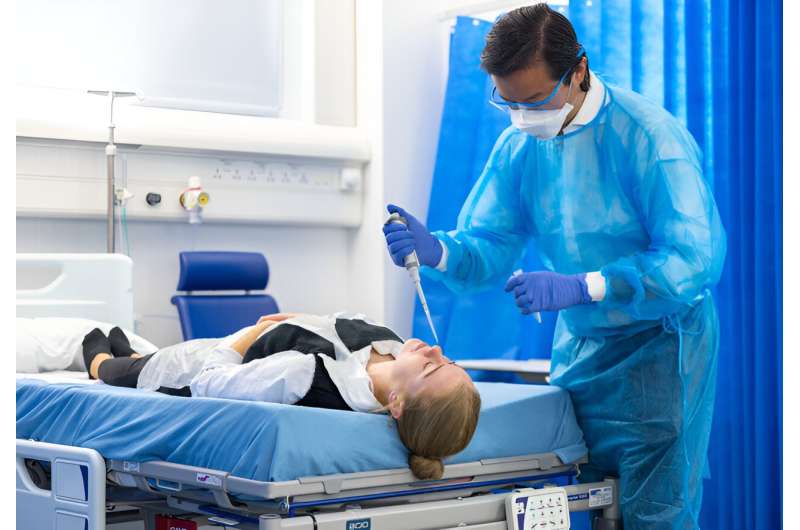
Clinician administering the virus through the nose, as part of the UK’s COVID-19 Human Challenge study. Credit: Imperial College London
Scientists have discovered new immune responses that help explain how some people avoid getting COVID-19.
Using single-cell sequencing, researchers from the Wellcome Sanger Institute, University College London (UCL), Imperial College London, Dutch Cancer Institute and collaborators studied immune responses against SARS infection -CoV-2 in healthy adult volunteers, in the world’s first study of the human challenge of COVID-19.
Not all exposed participants developed COVID-19 infection, allowing the team to uncover unique immune responses associated with resistance to sustained viral infection and disease.
The results, published in Nature, provide the most comprehensive timeline yet of how the body responds to exposure to SARS-CoV-2 or any infectious disease. This work is part of the Human Cell Atlas initiative to map every cell type in the human body.
Severe acute respiratory syndrome coronavirus 2 (SARS-CoV-2) has infected millions of people worldwide with coronavirus disease 2019 (COVID-19). Although this is potentially fatal, many will have been in contact with someone who tested positive for COVID-19, but have managed to avoid becoming ill themselves, whether that is remaining negative on the PCR test or to have an asymptomatic case of the disease.
While previous studies have examined COVID-19 patients after symptom onset, in this new study, researchers set out for the first time to capture immune responses upon exposure, in an immunologically naive cohort.
As part of the UK COVID-19 Human Challenge study, led by Imperial College London, 36 healthy adult volunteers with no history of COVID-19 were injected with the SARS-CoV-2 virus through the nose.
The researchers carried out detailed monitoring of the blood and lining of their noses, tracking the entirety of the infection as well as the activity of immune cells before the infection itself in 16 volunteers. Teams from the Wellcome Sanger Institute and UCL then used single-cell sequencing to generate a dataset of more than 600,000 individual cells.
In all participants, the team discovered novel responses involved in the immediate detection of the virus. This included activation of specialized mucosal immune cells in the blood and a reduction in inflammatory white blood cells that normally engulf and destroy pathogens.
Individuals who immediately cleared the virus did not show a typical generalized immune response, but instead developed subtle, never-before-seen innate immune responses. Researchers suggest that high levels of activity of a gene called HLA-DQA2 before exposure also helped people prevent the onset of prolonged infection.
In contrast, the six people who developed sustained SARS-CoV-2 infection showed a rapid immune response in the blood but a slower immune response in the nose, allowing the virus to establish itself there.
The researchers further identified common patterns among activated T cell receptors, which recognize and bind to virus-infected cells. This offers insight into immune cell communication and the potential for developing targeted T cell therapies against not only COVID-19, but also other diseases.
Dr Rik Lindeboom, co-first author of the study, now at the Netherlands Cancer Institute, said: “This was an incredibly unique opportunity to see what immune responses look like when encountering a new pathogen. – in adults without a history of COVID. -19, in an environment where factors such as timing of infection and comorbidities could be controlled.
Dr Marko Nikolić, lead author of the study at UCL and honorary consultant in respiratory medicine, said: “These results shed new light on the crucial early events that allow the virus to take hold or eliminate it. quickly before symptoms develop. We have a much better understanding of the full range of immune responses, which could provide the basis for developing potential treatments and vaccines that mimic these natural protective responses. »
Dr Sarah Teichmann, lead author of the study and co-founder of the Human Cell Atlas, formerly at the Wellcome Sanger Institute and now based at the Cambridge Stem Cell Institute at the University of Cambridge, said: “As we build the Grace At the Human Cell Atlas, we can better identify which of our cells are essential for fighting infections and understand why different people respond to coronavirus in different ways.
“Future studies can be compared to our reference dataset to understand how a normal immune response to a new pathogen compares to a vaccine-induced immune response.”
Shobana Balasingam, head of research in Wellcome’s infectious diseases team, said: “Human challenge models are an invaluable way of developing our understanding of how the body responds to infectious diseases. These studies allow us to closely monitor what happens from the time of infection by allowing us to track the immune response through the progression and severity of symptoms.
“These findings are an exciting addition to our evidence base on how different people might respond to or be protected against COVID-19 infections. We need to understand how factors such as natural exposure to the disease affect response from the body to the virus or a vaccine Therefore, it is crucial that studies like this are extended to low-resource settings where diseases are endemic, to ensure that we develop context-specific tools and therapies that work for them. the most vulnerable.
More information:
Rik Lindeboom, Human SARS-CoV-2 challenge reveals local and systemic response dynamics, Nature (2024). DOI: 10.1038/s41586-024-07575-x. www.nature.com/articles/s41586-024-07575-x
Provided by the Wellcome Trust Sanger Institute
Quote: Immune response study explains why some people don’t get COVID-19 (June 19, 2024), retrieved June 20, 2024 from https://medicalxpress.com/news/2024-06-immune-response-people- including-covid. HTML
This document is subject to copyright. Except for fair use for private study or research purposes, no part may be reproduced without written permission. The content is provided for information only.